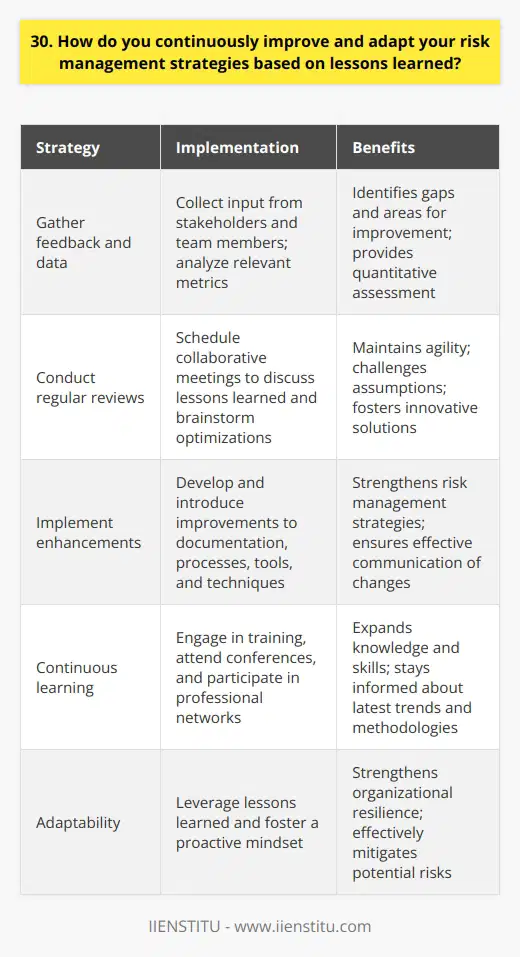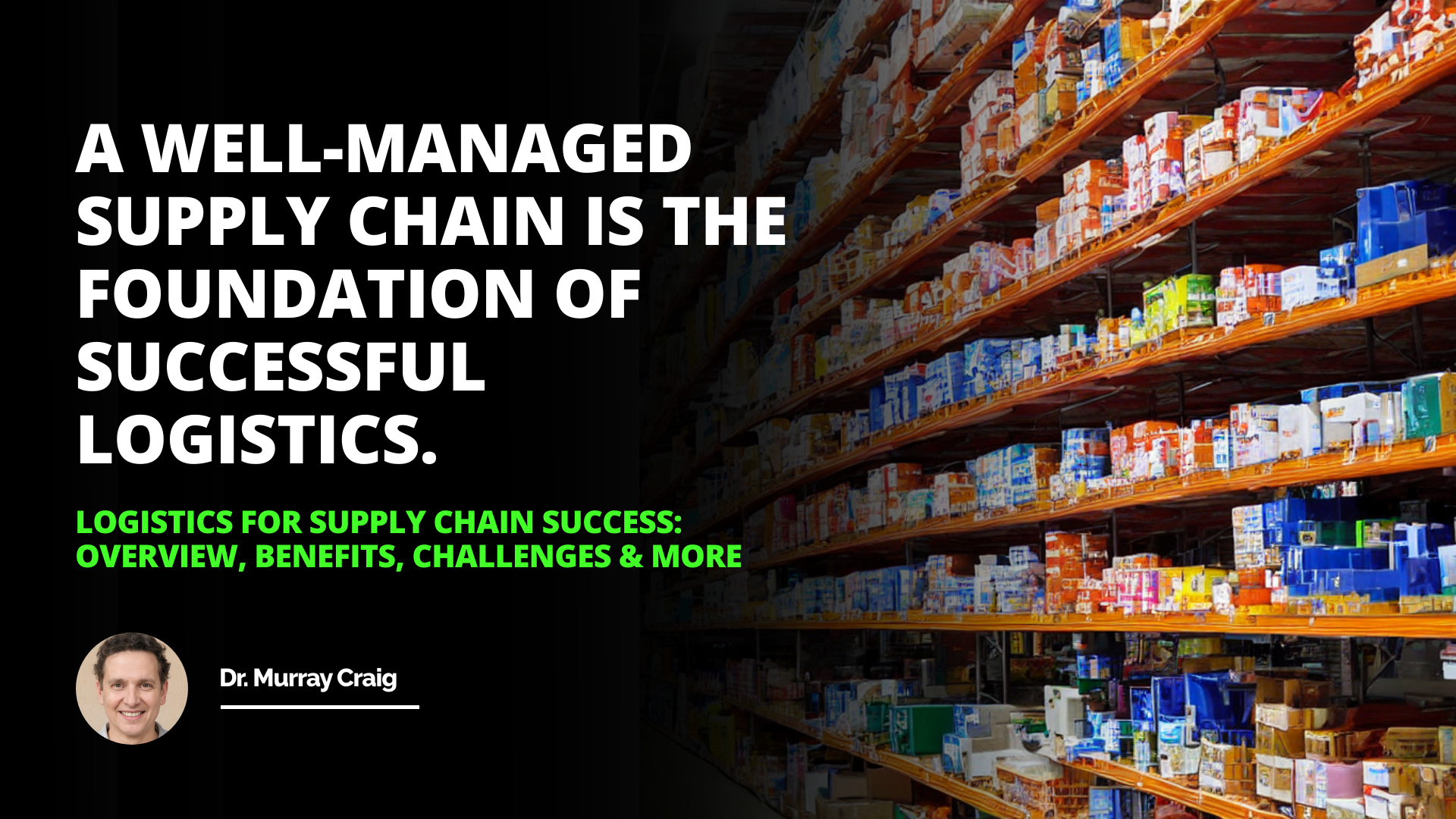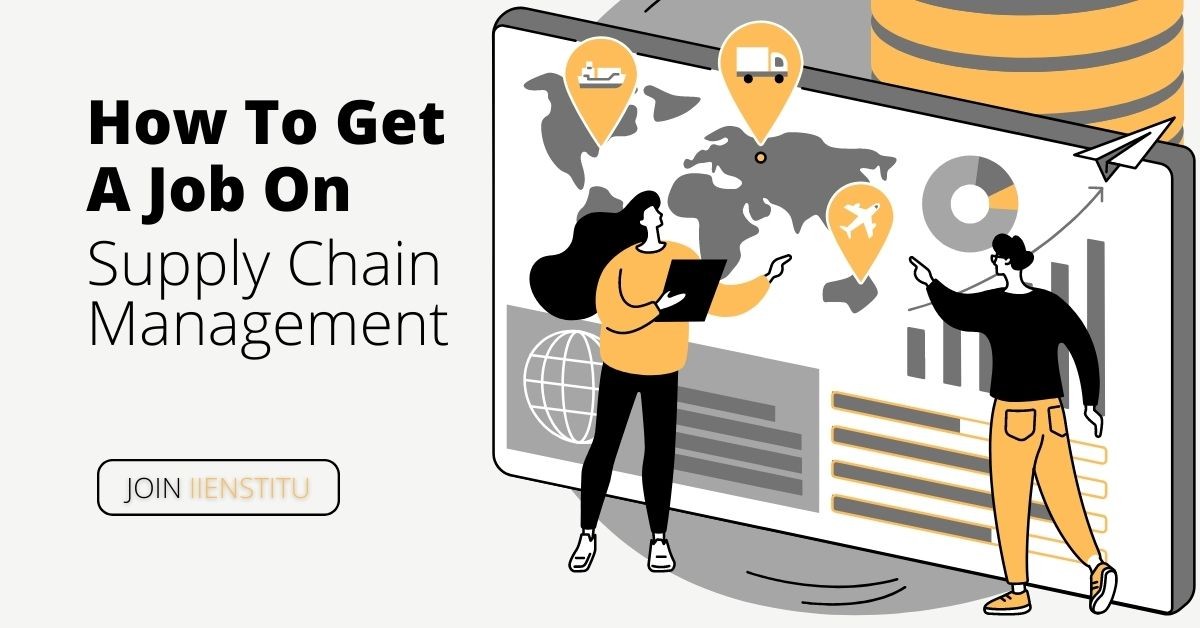
In today's complex and intricate business environment, the question, "How to manage risk within the supply chain?" is often posed by business entities and prospective job candidates alike.
The supply chain is a critical component of any business structure; thus, its management and risk mitigation is crucial.
Why is this Interview Question Asked: How to Manage Risk Within the Supply Chain?
Companies need to know that you understand the potential for risk within supply chains and that you have the necessary skills to handle it strategically.
The reality of risk within the supply chain cannot be overstated. It's a common query in interviews for roles that involve managing complex logistics or supply chain processes in an organization.
The Purpose of the Question
The main objective of this question is to gauge the candidate's comprehension of risk management principles as they apply to the supply chain process.
Employers want to see that you not only understand the concept of risk but that you can apply your knowledge to real-life, practical scenarios.
At What Interview Level Is It Asked?
This question is typically asked during interviews for mid-level to senior-level positions. Roles such as Supply Chain Analyst, Logistics Coordinator, or even Supply Chain Manager would likely encounter this question as part of their interview process.
However, occasionally, it can be asked in entry-level roles which require a strong understanding of supply chain management as a foundational skill.
Related course: Supply Chain Management
What Kind of Answer is Expected from the Candidate?
The ideal answer should showcase your understanding of risk management strategies, your problem-solving abilities, and your foresight in identifying potential risks before they arise.
Employers are looking for comprehensive responses that demonstrate your ability to handle unforeseeable global and local factors that can disrupt supply chain operations. They want you to discuss concrete strategies or past experiences managing risks effectively.
Possible Answers to Consider
Consider sharing practical experiences of managing risk within a supply chain in previous roles. Perhaps you could discuss a specific incident in which you identified potential supply chain risk, implemented proactive measures to prevent this risk, and the outcome of these actions.
Discuss tools or technologies that can help mitigate risk, such as predictive analytics, big data, Internet of Things technologies, or real-time tracking software.
Potential answers could also involve emphasizing your understanding of maintaining strong relationships with suppliers, diversifying the supplier base, or regular risk assessments.
Be sure to portray your knowledge of various types of supply chain risks like operational risks, disruption risks, demand risks, and procurement risks. Demonstrate your understanding of the appropriate strategies to handle each.
Conclusion - How to Manage Risk within the Supply Chain?
In today's rapidly evolving and highly-connected business environment, understanding how to manage risk within the supply chain is an invaluable skill-set. It involves not only identifying and assessing potential risks but also developing and implementing strategies for mitigating these threats effectively.
From maintaining strong supplier relationships to leveraging high-tech solutions, the strategies are multifaceted. By preparing well and highlighting your experience, insights, and comprehension of this significant area, you can certainly ace interviews and set yourself apart.
Overall, managing risk within a supply chain is significant for maintaining organizational efficiency and profitability. Showcasing your expertise and ability to handle potential risks will go a long way in proving your worth as a capable and reliable supply chain professional.
Strategies for Identifying and Mitigating Risks in Supply Chain
Impact of External Factors on Supply Chain Risk Management
Evaluation Methods for Supply Chain Risk Management Effectiveness
Similar interview questions:
What methods can be employed to control risks in the supply chain process?
Could you explain different strategies for effective supply chain risk management?
What are some of the best practices for managing supply chain risks?
What steps should be taken to mitigate risks within the supply chain?
What is the best approach to handle risks in the supply chain?
How can risk within the supply chain be effectively curbed?
What techniques are recommended for countering risk in the supply chain?
Could you outline procedures to oversee risk in a supply chain?
How can we implement risk management within our supply chain?
Can you detail the actions for controlling unforeseen hazards in the supply chain operation?
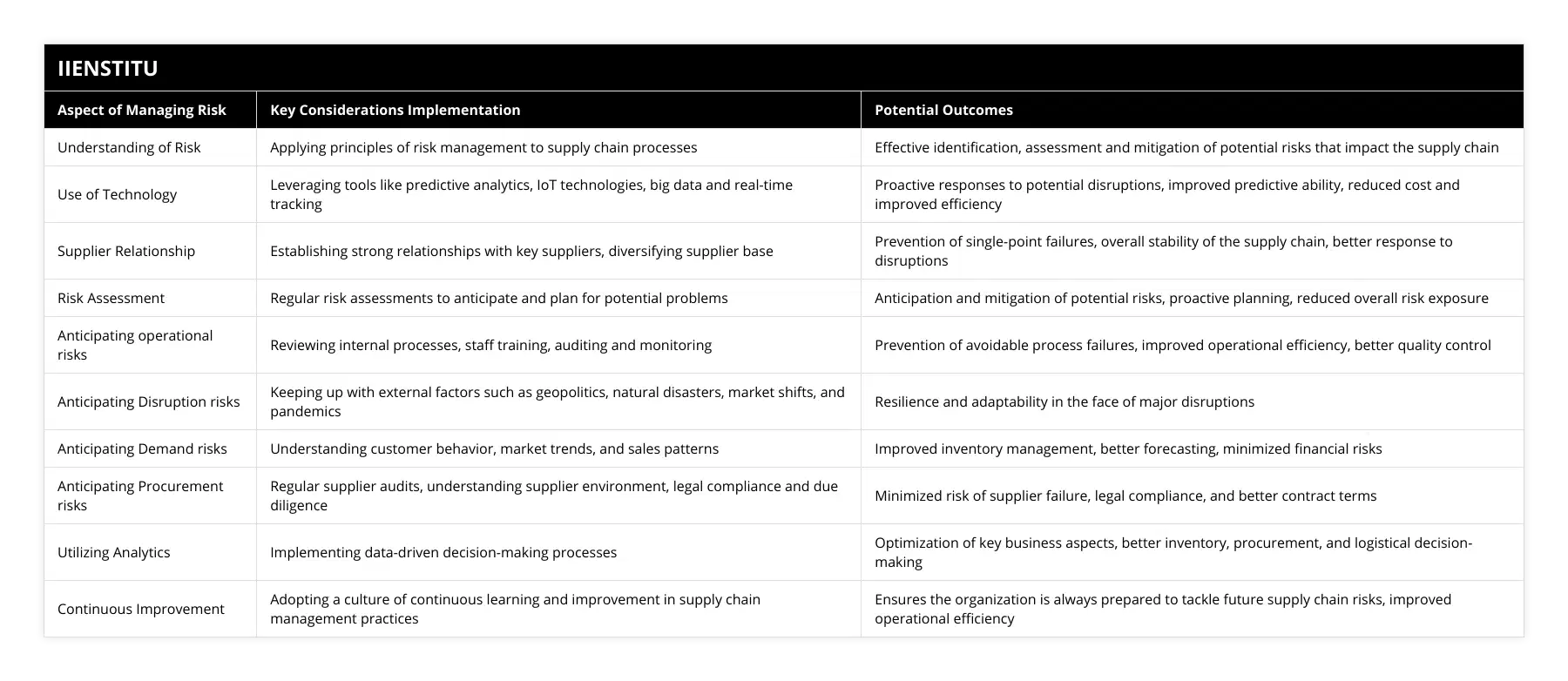
Frequently Asked Questions
1. What strategies do you employ to identify potential risks in your supply chain?
When it comes to identifying potential risks in the supply chain, I have a few key strategies that I employ. First and foremost, I believe in building strong relationships with suppliers. By establishing open lines of communication and trust, I can stay informed about any issues or concerns that may arise.
Thorough Research and Due Diligence
Before onboarding any new supplier, I conduct thorough research and due diligence. This includes assessing their financial stability, reputation, and track record. I also review their quality control processes and ensure they align with our company's standards.
Regular Audits and Inspections
To maintain oversight and mitigate risks, I implement regular audits and inspections of our suppliers' facilities. This allows me to identify any potential issues early on and work collaboratively with suppliers to address them.
Diversifying Supplier Base
Another strategy I employ is diversifying our supplier base. By not relying on a single supplier for critical components or materials, we can reduce the impact of any disruptions or quality issues that may occur.
Continuous Monitoring and Adaptation
Finally, I believe in continuous monitoring and adaptation. Supply chain risks are constantly evolving, so it's crucial to stay vigilant and be prepared to adjust our strategies as needed. By staying proactive and agile, we can minimize the impact of any potential risks on our operations.
At the end of the day, identifying and mitigating supply chain risks is a collaborative effort. It requires strong partnerships, effective communication, and a commitment to continuous improvement. By employing these strategies, I'm confident in my ability to navigate potential risks and ensure the smooth flow of our supply chain.
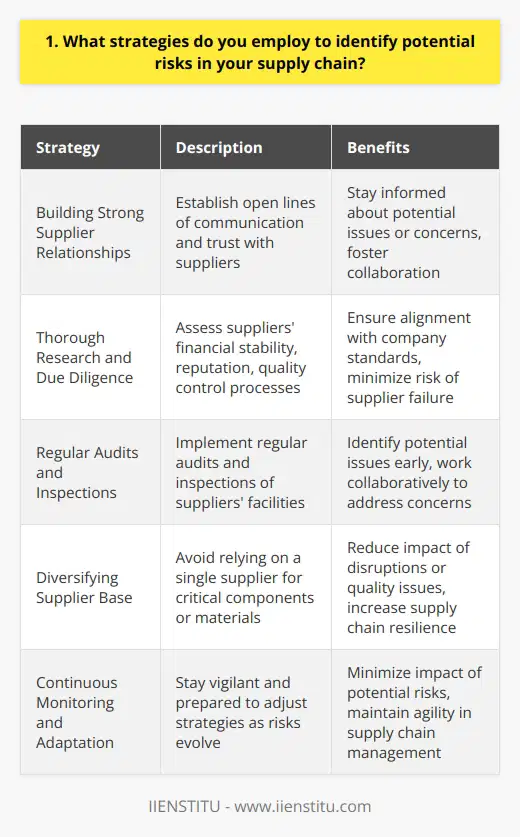
2. How do you prioritize the risks within your supply chain?
When prioritizing risks within my supply chain, I first identify potential vulnerabilities and assess their impact on operations. This involves gathering data from suppliers, analyzing market trends, and collaborating with cross-functional teams.
Categorizing Risks
I categorize risks based on their likelihood and potential impact. High-probability, high-impact risks receive top priority. These may include supplier financial instability, geopolitical events, or natural disasters that could disrupt the flow of goods.
Developing Mitigation Strategies
For each prioritized risk, I develop targeted mitigation strategies. This might involve diversifying the supplier base, increasing inventory levels for critical components, or implementing more rigorous quality control measures. The goal is to minimize exposure and ensure continuity of supply.
Monitoring and Adjusting
I continuously monitor the supply chain for emerging risks and adjust priorities as needed. Regular communication with suppliers and staying attuned to industry developments are key. By being proactive and agile, I can quickly respond to changing circumstances and keep the supply chain running smoothly.
In my previous role, I faced a situation where a key supplier was experiencing financial difficulties. By identifying this risk early and working closely with the supplier to develop a contingency plan, we were able to avoid a major disruption to our production schedule. It taught me the importance of staying vigilant and being prepared for the unexpected.
Prioritizing supply chain risks requires a combination of analytical thinking, collaboration, and adaptability. It's a continuous process of assessing, mitigating, and monitoring to ensure the resilience and efficiency of the supply chain.
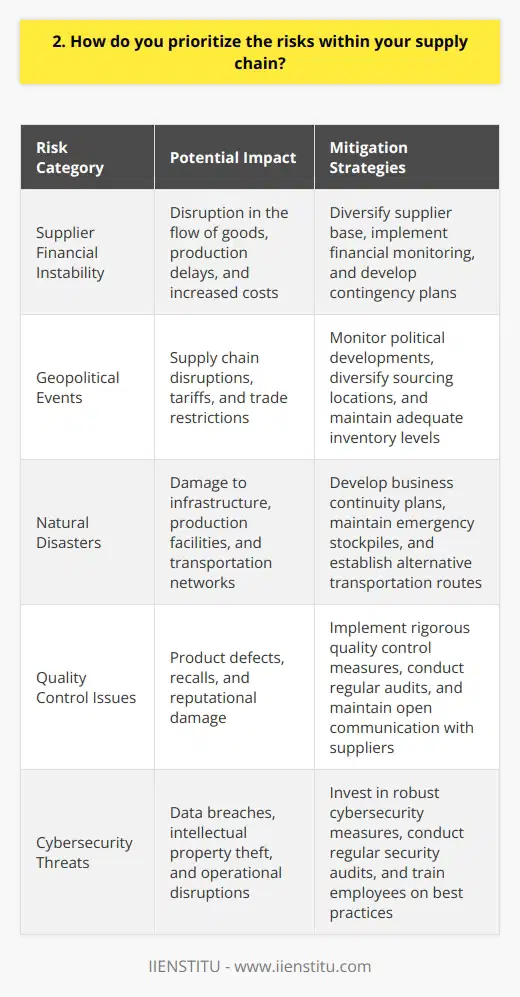
3. What tools or technologies do you use to monitor and manage supply chain risks?
As a supply chain professional, I rely on several tools and technologies to monitor and manage risks effectively. One key tool is a robust enterprise resource planning (ERP) system, which provides real-time visibility into our operations. This allows us to quickly identify potential issues and take proactive measures to mitigate them.
Supplier Risk Assessment
I also conduct regular supplier risk assessments, using a combination of financial analysis, on-site audits, and performance evaluations. By closely monitoring our suppliers' financial health, quality control processes, and delivery track records, we can anticipate and address any potential disruptions to our supply chain.
Data Analytics and Predictive Modeling
Another essential tool in my arsenal is data analytics and predictive modeling. By leveraging historical data and machine learning algorithms, we can forecast demand, optimize inventory levels, and simulate various risk scenarios. This enables us to develop contingency plans and adapt our strategies based on changing market conditions and potential disruptions.
Collaboration and Communication
Finally, I believe that effective collaboration and communication are crucial for managing supply chain risks. I work closely with our internal teams, suppliers, and customers to ensure that everyone is aligned and informed. We use collaborative platforms and regular meetings to share information, discuss challenges, and develop joint solutions.
By combining these tools and approaches, I strive to create a resilient and agile supply chain that can withstand disruptions and support our business goals. It's an ongoing process that requires continuous monitoring, adaptation, and improvement, but I find it incredibly rewarding to help our company navigate the complex world of supply chain management.
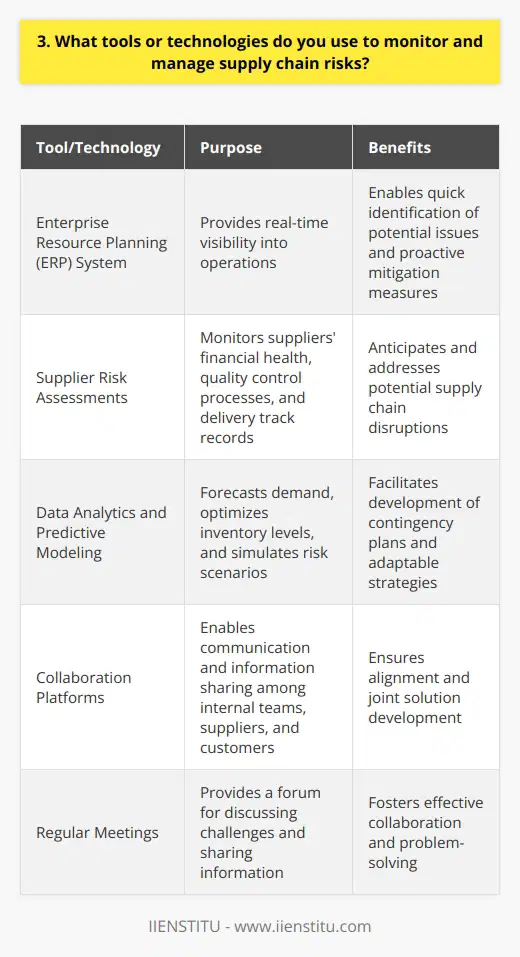
4. How do you develop contingency plans for potential supply chain disruptions?
When it comes to developing contingency plans for potential supply chain disruptions, I follow a systematic approach. First, I identify the most critical components of our supply chain. These are the elements that, if disrupted, would have the most significant impact on our operations.
Assessing Risks and Vulnerabilities
Next, I assess the risks and vulnerabilities associated with each critical component. This involves considering factors such as the likelihood of a disruption occurring, the potential impact on our business, and the time it would take to recover.
For example, when I worked at my previous company, we heavily relied on a single supplier for a key raw material. I recognized this as a significant risk and worked with my team to develop a contingency plan.
Developing Backup Plans and Alternatives
Based on the identified risks, I develop backup plans and alternatives. This might involve sourcing from alternative suppliers, increasing inventory levels, or even redesigning products to use more readily available components.
In the case of our single supplier, we actively searched for and qualified alternative suppliers. We also increased our safety stock of the raw material to buffer against potential disruptions.
Continuous Monitoring and Updating
Contingency planning is not a one-time exercise. I continuously monitor our supply chain for potential issues and update our plans as needed. This helps us stay prepared and responsive in the face of changing circumstances.
I also believe in the importance of communication and collaboration. I work closely with our suppliers, logistics partners, and internal stakeholders to ensure everyone is aligned and prepared to execute our contingency plans if necessary.
Testing and Simulating Scenarios
Finally, I believe in testing our contingency plans through simulations and drills. This allows us to identify any gaps or weaknesses in our plans and make improvements before a real disruption occurs.
In summary, developing robust contingency plans involves a proactive, systematic approach. By identifying risks, developing alternatives, monitoring continuously, and testing our plans, we can minimize the impact of supply chain disruptions on our business.
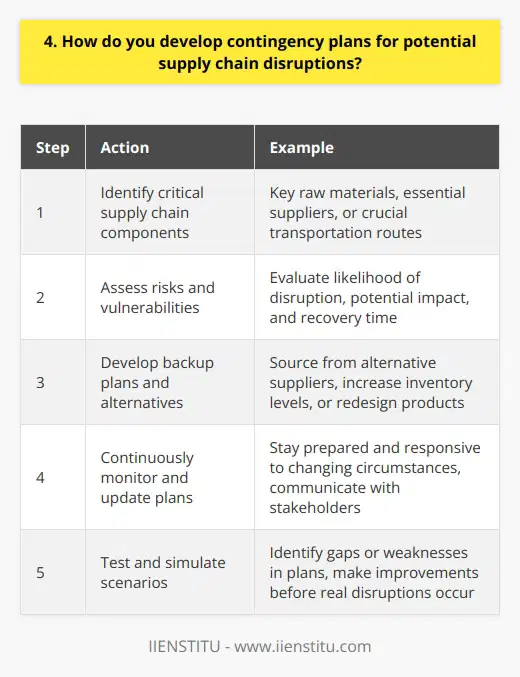
5. What steps do you take to ensure the resilience of your supply chain?
When it comes to ensuring the resilience of my supply chain, I take a proactive and multifaceted approach. First and foremost, I prioritize building strong relationships with my suppliers. I believe that open communication and trust are key to weathering any storms that may come our way.
Diversifying Suppliers
One strategy I employ is diversifying my supplier base. I don't put all my eggs in one basket. By working with multiple suppliers across different regions, I mitigate the risk of disruptions caused by localized issues.
Conducting Regular Audits
I also conduct regular audits of my suppliers. I visit their facilities, assess their processes, and ensure they meet our quality and sustainability standards. This hands-on approach allows me to identify potential risks early on and address them before they escalate.
Implementing Technology
Technology plays a crucial role in enhancing supply chain resilience. I leverage tools like real-time monitoring systems and predictive analytics. These help me track inventory levels, anticipate demand fluctuations, and optimize our logistics network.
Developing Contingency Plans
Despite our best efforts, disruptions can still occur. That's why I develop robust contingency plans. I work with my team to map out potential scenarios and create step-by-step response strategies. By being prepared, we can swiftly adapt and minimize the impact on our operations.
Fostering a Culture of Resilience
Ultimately, I believe that resilience starts from within. I strive to foster a culture of agility, adaptability, and continuous improvement. I empower my team to think creatively, share ideas, and take ownership of their work. Together, we build a supply chain that can withstand challenges and emerge stronger.
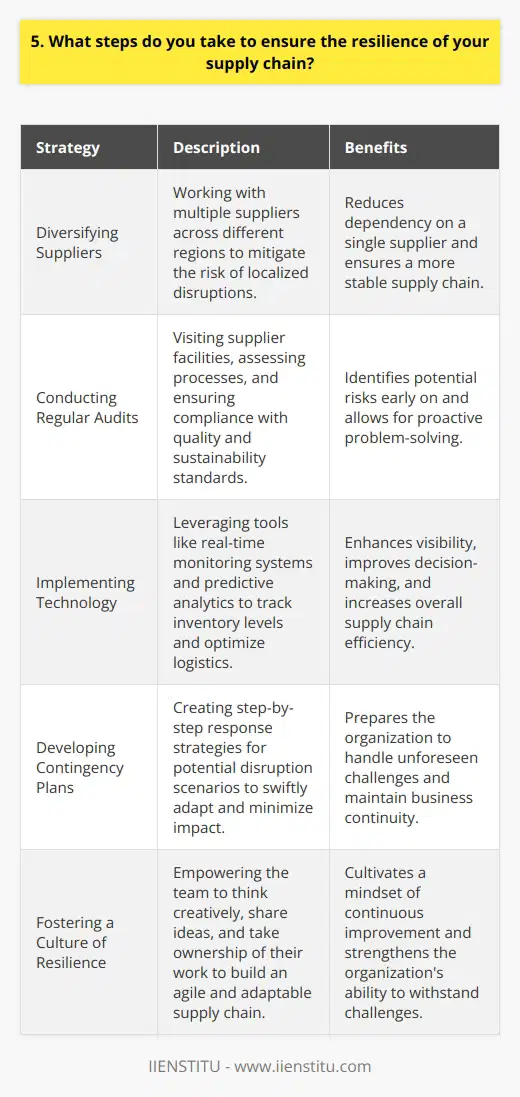
6. How do you collaborate with suppliers to mitigate supply chain risks?
When collaborating with suppliers to mitigate supply chain risks, I believe in building strong, trusting relationships. I've found that open communication is key to identifying potential issues early on.
Proactive Planning
I work closely with suppliers to develop contingency plans for various disruption scenarios. Together, we brainstorm creative solutions and alternative sourcing options to ensure continuous supply.
Diversifying the Supply Base
In my experience, relying on a single supplier can be risky. I advocate for diversifying the supply base to reduce dependency and increase flexibility.
Thorough Supplier Vetting
Before onboarding new suppliers, I conduct comprehensive assessments of their financial stability, quality control processes, and business continuity plans. This due diligence helps minimize surprises down the road.
Collaborative Problem-Solving
When supply chain disruptions do occur, I believe in tackling them as a team. I engage suppliers in joint problem-solving sessions to quickly identify root causes and implement effective solutions.
Continuous Improvement
I'm always looking for ways to strengthen our supply chain resilience. I regularly review performance metrics with suppliers and explore opportunities for process improvements and risk mitigation strategies.
By fostering collaboration, proactive planning, and a commitment to continuous improvement, I aim to build a robust supply chain that can weather any storm.

7. What metrics do you use to assess the effectiveness of your risk management strategies?
When assessing the effectiveness of my risk management strategies, I focus on several key metrics. First and foremost, I track the frequency and severity of incidents over time. By monitoring these numbers, I can identify trends and gauge whether our risk mitigation efforts are having a positive impact.
Analyzing Financial Impacts
Another crucial metric is the financial impact of incidents. I carefully analyze the costs associated with each event, including direct losses, remediation expenses, and potential reputational damage. By quantifying these impacts, I can prioritize our risk management initiatives and allocate resources accordingly.
Conducting Regular Assessments
I also believe in the importance of regular risk assessments. My team conducts thorough evaluations of our systems, processes, and controls on a periodic basis. We identify vulnerabilities, assess their likelihood and potential impact, and develop targeted action plans to address them. These assessments provide valuable insights into the effectiveness of our risk management strategies.
Collaborating with Stakeholders
Collaboration is key to successful risk management. I actively engage with stakeholders across the organization, seeking their input and feedback. By fostering open communication and incorporating diverse perspectives, we can identify blind spots and develop more robust risk mitigation plans.
Ultimately, the effectiveness of our risk management strategies is measured by our ability to anticipate, prevent, and respond to incidents. By continuously monitoring key metrics, conducting assessments, and collaborating with stakeholders, I strive to create a resilient and proactive risk management culture within the organization.
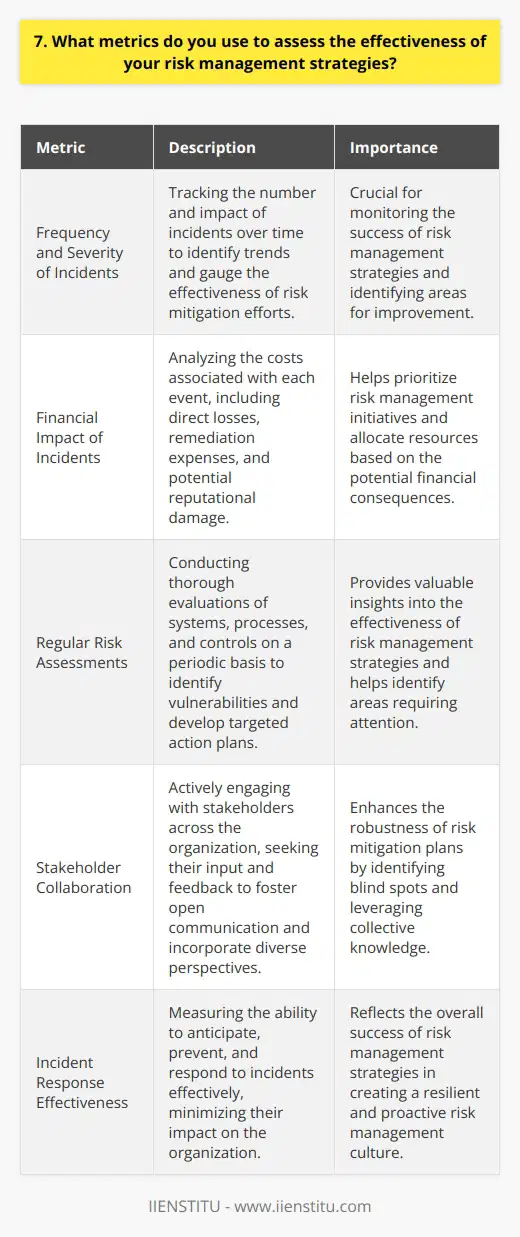
8. How do you ensure transparency and visibility throughout your supply chain?
As a supply chain professional, I prioritize transparency and visibility throughout our entire network of suppliers and partners. This commitment starts with establishing clear communication channels and setting expectations from the very beginning of any new relationship.
Leveraging Technology for Real-Time Insights
One of the key ways we maintain transparency is by investing in cutting-edge supply chain management software. These tools provide real-time data on inventory levels, shipment statuses, and potential disruptions, enabling us to make informed decisions quickly.
I remember one instance where our software alerted us to a potential delay at a critical supplier's facility. By identifying the issue early, we were able to work with the supplier to implement contingency plans and minimize the impact on our production schedule.
Building Trust Through Regular Audits and Site Visits
In addition to leveraging technology, I believe in the importance of regular audits and site visits. By physically visiting our suppliers' facilities and conducting thorough audits, we can ensure that they are meeting our standards for quality, safety, and ethical practices.
These visits also provide an opportunity to build stronger relationships with our suppliers. I've found that face-to-face interactions help foster a sense of trust and collaboration, which is essential for maintaining transparency.
Empowering Our Team to Make Informed Decisions
Finally, I believe in empowering our team members to make informed decisions based on the data and insights we gather. By providing them with the tools and knowledge they need to understand our supply chain, we can create a culture of transparency that permeates every level of our organization.
Transparency and visibility are not just buzzwords to me – they are essential components of a successful supply chain strategy. By combining technology, regular audits, and a commitment to empowering our team, we can ensure that our supply chain remains transparent, efficient, and responsive to the needs of our customers.
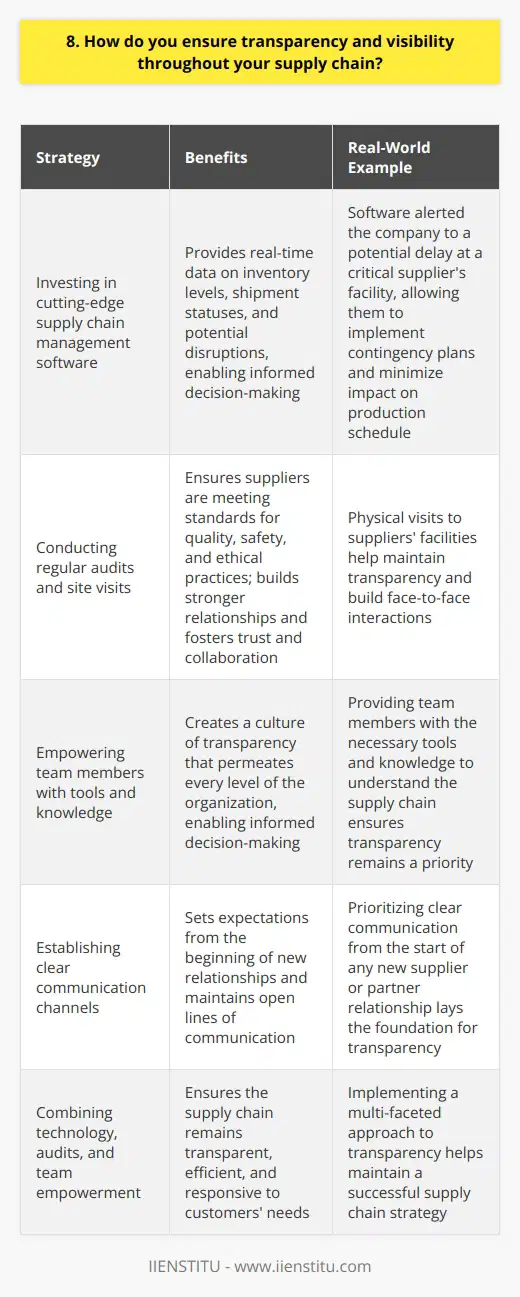
9. What processes do you have in place to quickly respond to supply chain disruptions?
At our company, we have a robust system in place to quickly respond to supply chain disruptions. Here are some of the key processes we rely on:
Proactive Monitoring and Risk Assessment
We continuously monitor our supply chain for potential risks and vulnerabilities. Our team assesses suppliers, tracks market trends, and identifies potential disruptions before they occur. By staying ahead of the game, we can quickly adapt and mitigate risks.
Diversified Supplier Network
Over the years, we've built a diverse network of reliable suppliers across different regions. This helps us maintain flexibility and reduces our dependence on any single supplier. If one supplier faces issues, we can swiftly shift production to alternative sources without significant delays.
Contingency Planning and Scenario Analysis
We regularly conduct scenario analyses to prepare for various supply chain disruptions. Our team develops contingency plans that outline clear steps to take in case of emergencies. These plans cover everything from alternative transportation routes to backup inventory strategies.
Real-time Communication and Collaboration
Effective communication is crucial during supply chain disruptions. We leverage real-time communication tools to stay connected with suppliers, logistics partners, and internal teams. This ensures everyone is on the same page and can quickly coordinate responses to minimize the impact of disruptions.
Agile Decision-Making and Problem-Solving
Our team is empowered to make swift decisions when faced with supply chain challenges. We foster a culture of problem-solving and encourage out-of-the-box thinking. By being agile and adaptable, we can quickly implement solutions and keep our operations running smoothly.
These processes have helped us successfully navigate supply chain disruptions in the past. I'm confident that my experience and skills in this area would be a valuable asset to your company.
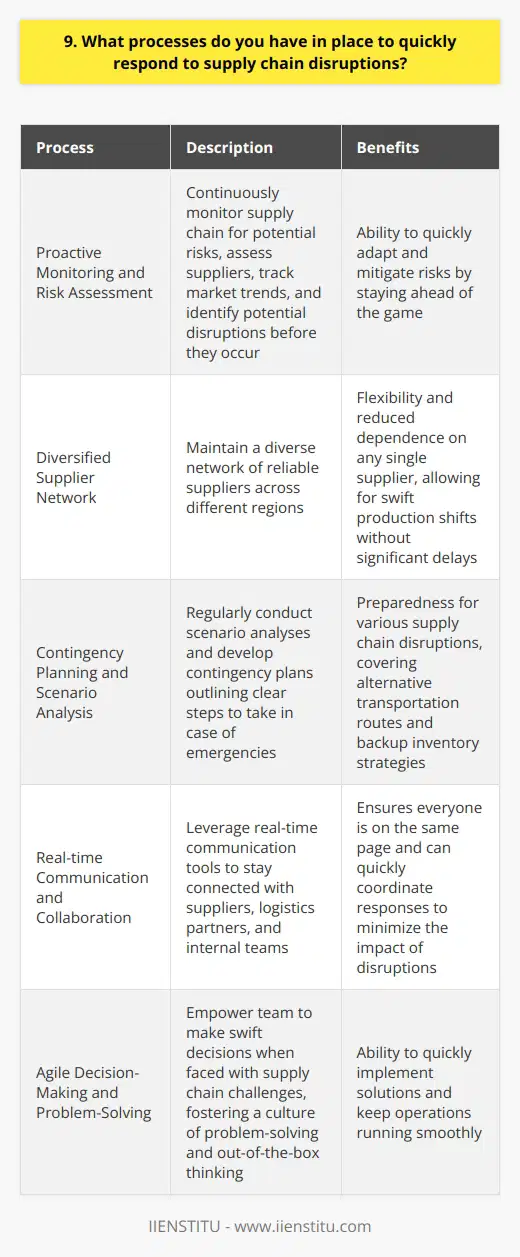
10. How do you balance the costs of risk management with the potential impact of disruptions?
Balancing the costs of risk management with the potential impact of disruptions is a delicate act. I always start by identifying the most critical risks to our operations. Then, I prioritize those risks based on their likelihood and potential impact.
Conducting a Cost-Benefit Analysis
For each risk, I conduct a thorough cost-benefit analysis. I weigh the costs of implementing risk mitigation strategies against the potential losses from a disruption. This helps me determine which risks are worth investing in and which ones we can tolerate.
Collaborating with Stakeholders
I collaborate closely with stakeholders across the organization to gather insights and perspectives. Together, we assess the potential impact of disruptions on different areas of the business. This collaborative approach ensures that we have a comprehensive understanding of the risks we face.
Implementing Targeted Risk Management Strategies
Based on the cost-benefit analysis and stakeholder input, I develop targeted risk management strategies. These strategies are designed to mitigate the most critical risks while being cost-effective. I focus on implementing measures that provide the greatest protection for our operations.
Monitoring and Reviewing Risks
Risk management is an ongoing process. I regularly monitor and review our risk landscape to identify any changes or emerging threats. By staying proactive and adaptive, I can adjust our risk management strategies as needed to keep pace with evolving risks.
Balancing Risk and Resilience
Ultimately, my goal is to strike a balance between risk management and operational resilience. I aim to invest in risk mitigation measures that enhance our ability to withstand and recover from disruptions. By carefully balancing costs and potential impacts, I strive to create a robust and resilient organization.
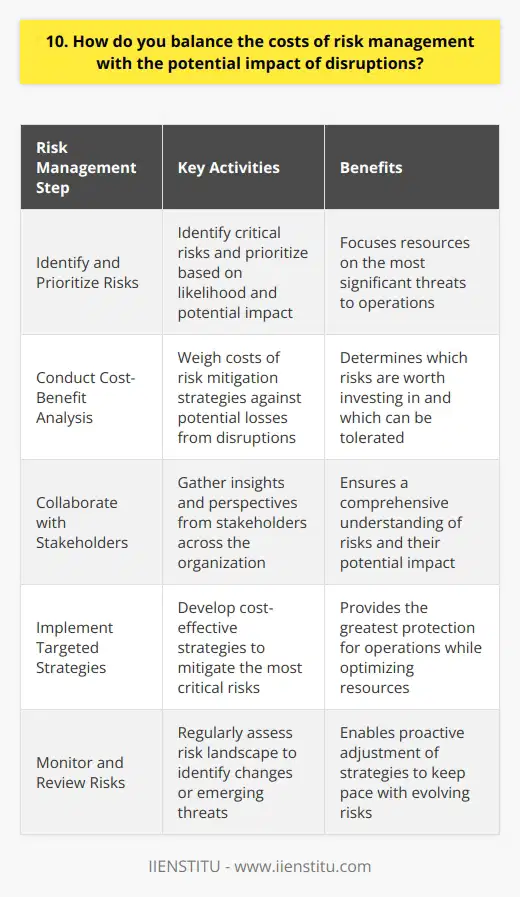
11. What role does data analytics play in your supply chain risk management?
Data analytics plays a crucial role in my supply chain risk management approach. By leveraging data, I can identify potential risks and mitigate them proactively.
Identifying Risks Through Data
I utilize data analytics to monitor key performance indicators across the supply chain. This allows me to detect anomalies and potential risks early on.
For example, if I notice a sudden increase in lead times from a specific supplier, it could indicate issues at their end. By identifying this risk promptly, I can take steps to address it before it escalates.
Mitigating Risks with Data-Driven Decisions
Data analytics enables me to make informed decisions to mitigate supply chain risks. By analyzing historical data and trends, I can develop contingency plans and strategize effectively.
In one instance, data revealed that a particular raw material was prone to shortages during certain months. Armed with this insight, I proactively built up inventory levels to ensure uninterrupted production.
Continuous Improvement through Data Analysis
I believe in continuously improving supply chain risk management through data-driven insights. By regularly analyzing data, I can identify areas for optimization and implement best practices.
Data analytics has helped me streamline processes, reduce costs, and enhance overall supply chain resilience. It's an invaluable tool in my risk management arsenal.
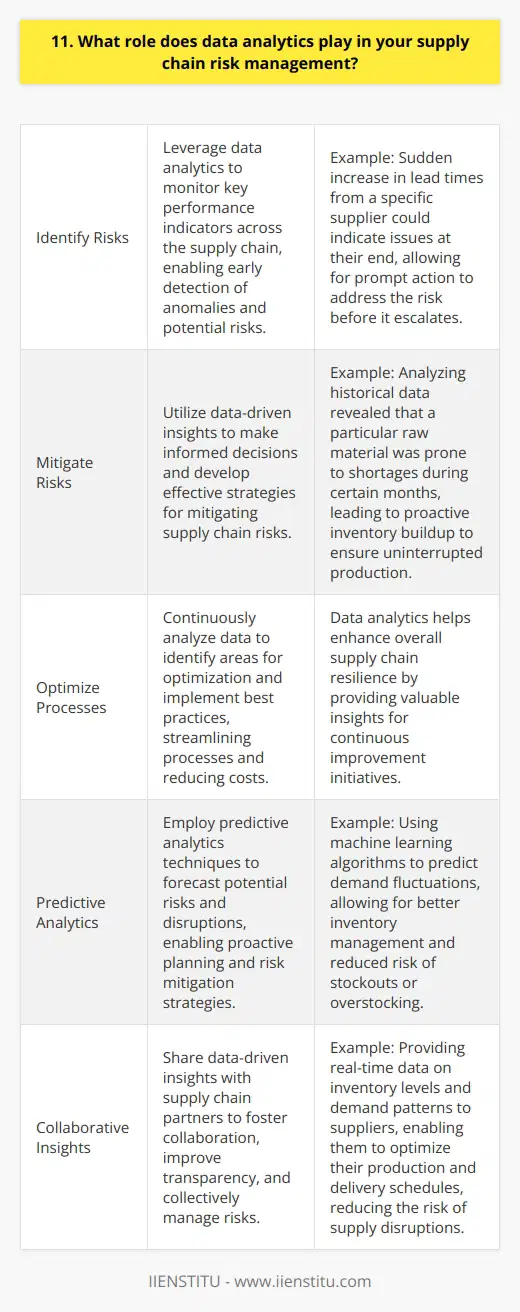
12. How do you ensure that your suppliers adhere to your risk management standards?
As a supply chain manager, I take several steps to ensure our suppliers meet our risk management standards:
Thorough Vetting Process
Before onboarding any new supplier, I conduct a comprehensive background check. This includes reviewing their financial stability, industry reputation, and compliance history. I also personally visit their facilities to assess their operations and practices firsthand.
Clear Communication of Expectations
From the very beginning, I clearly communicate our company's risk management standards and expectations to all suppliers. We collaborate to develop detailed contracts that outline specific requirements for quality control, ethical sourcing, data security, and more. Frequent check-ins help ensure everyone remains on the same page.
Regular Audits and Inspections
Trust but verify - that's my motto! I schedule regular audits and inspections of our suppliers' facilities. This allows me to monitor their adherence to our standards and quickly address any issues that arise. Unannounced spot checks keep everyone on their toes.
Continuous Improvement Programs
I don't expect perfection from day one. Instead, I work closely with suppliers to implement continuous improvement programs. We set achievable milestones, provide training and resources, and celebrate progress along the way. It's a collaborative effort to raise the bar over time.
Swift Action for Non-Compliance
In rare cases when a supplier consistently fails to meet our risk management standards, I take swift action. This may involve escalating the issue to senior leadership, implementing corrective action plans, or even terminating the relationship if necessary. The integrity of our supply chain is paramount.
By taking a proactive and hands-on approach, I ensure our suppliers are true partners in risk management excellence.
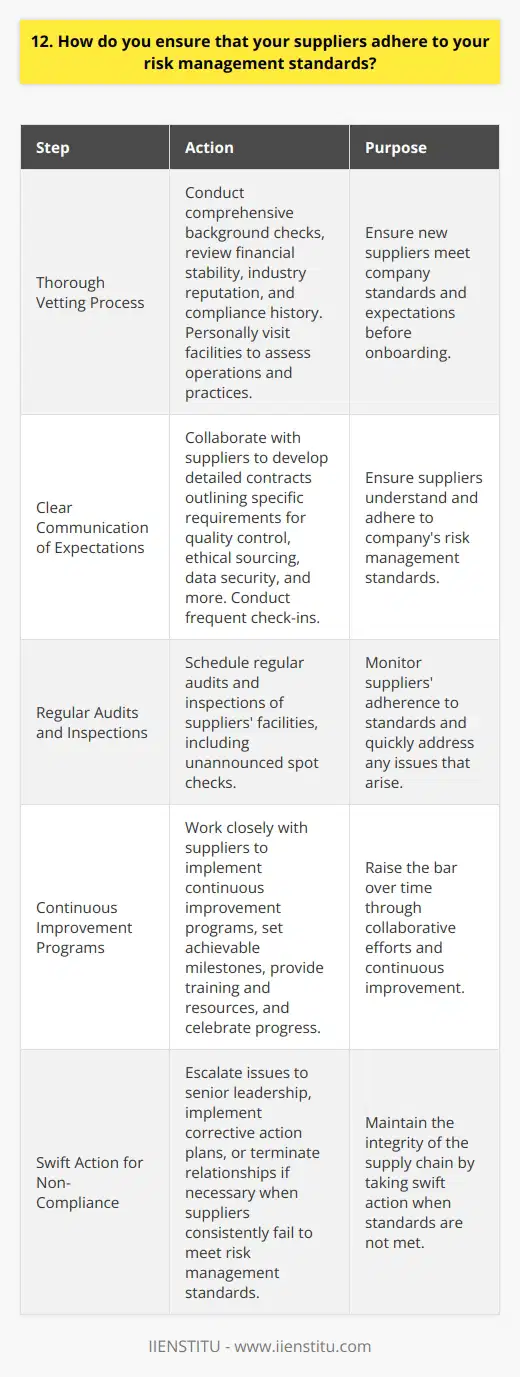
13. What steps do you take to diversify your supplier base and reduce dependencies?
When it comes to diversifying our supplier base and reducing dependencies, I take a proactive and strategic approach. I believe that building a robust and diverse supplier network is crucial for mitigating risks and ensuring business continuity.
Conducting Thorough Research
I start by conducting thorough research to identify potential suppliers across different regions and industries. This helps me discover new opportunities and reduces reliance on a single supplier or region. I attend trade shows, leverage industry networks, and utilize online resources to find qualified suppliers.
Evaluating Supplier Capabilities
Once I have a pool of potential suppliers, I carefully evaluate their capabilities, quality standards, and financial stability. I request samples, conduct site visits, and engage in discussions to assess their ability to meet our requirements. This due diligence process helps me select reliable and capable suppliers.
Establishing Backup Suppliers
To reduce dependencies, I always aim to establish backup suppliers for critical components or services. Having alternative sources ensures that we can maintain our operations even if a primary supplier faces disruptions. I negotiate contracts with backup suppliers and maintain regular communication to keep them engaged.
Fostering Long-Term Relationships
I believe in fostering long-term relationships with our suppliers built on trust, transparency, and mutual growth. I engage in regular performance reviews, provide feedback, and collaborate on improvement initiatives. Strong partnerships help us navigate challenges together and ensure a stable supply chain.
Continuous Monitoring and Adaptation
I continuously monitor market trends, geopolitical risks, and supplier performance to identify potential issues proactively. If I detect any red flags or disruptions, I swiftly adapt our sourcing strategy and explore alternative suppliers. Staying agile and responsive is key to maintaining a resilient supply chain.
By implementing these steps, I have successfully diversified our supplier base and reduced dependencies in my previous roles. I am confident that I can bring the same strategic approach and risk mitigation mindset to this position.

14. How do you assess the financial stability and reliability of your suppliers?
When assessing the financial stability and reliability of suppliers, I follow a thorough process. First, I gather essential information about their business operations and financial health.
Collecting Financial Data
I request financial statements, including balance sheets and income statements, from potential suppliers. These documents provide valuable insights into their revenue, expenses, assets, and liabilities. I also inquire about their credit history and any outstanding debts or legal issues.
Analyzing Financial Ratios
Using the financial data, I calculate key ratios such as the current ratio, debt-to-equity ratio, and profit margins. These ratios help me assess the supplier's liquidity, leverage, and profitability. I compare these ratios to industry benchmarks to gauge their financial performance relative to competitors.
Evaluating Business Stability
Beyond financial metrics, I consider factors that contribute to a supplier's overall stability. I research their market reputation, customer reviews, and years in business. Longevity and positive customer experiences indicate a reliable and sustainable operation.
Monitoring Industry Trends
I stay informed about industry trends and market conditions that may impact suppliers' financial stability. Economic downturns, raw material price fluctuations, or regulatory changes can affect their ability to fulfill orders consistently. By proactively monitoring these factors, I can anticipate potential risks.
Building Long-Term Relationships
I believe in fostering long-term partnerships with reliable suppliers. Regular communication and transparency are key to building trust. I schedule periodic meetings to discuss their financial health, production capacity, and any challenges they face. This proactive approach allows for early identification and resolution of potential issues.
In my experience, a comprehensive assessment of financial stability, business practices, and industry dynamics is crucial when selecting suppliers. By following this thorough process, I have successfully collaborated with dependable partners who have contributed to our company's success.
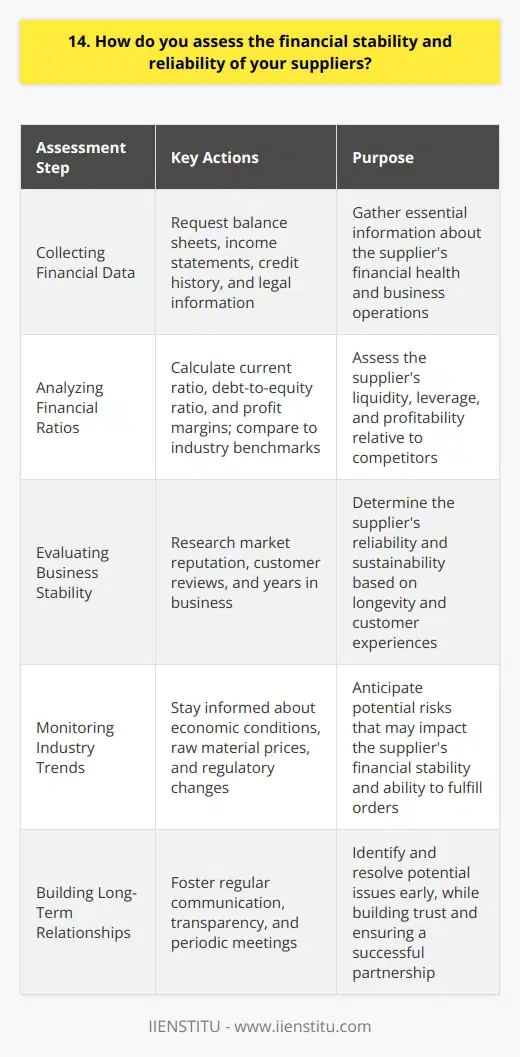
15. What measures do you have in place to protect against cyber threats in your supply chain?
As a cybersecurity professional, I understand the importance of protecting against cyber threats in the supply chain. I have several measures in place to ensure the security of our systems and data.
Comprehensive Risk Assessment
I conduct regular risk assessments to identify potential vulnerabilities in our supply chain. This includes evaluating the security practices of our vendors and partners. By understanding the risks, we can implement targeted security controls to mitigate them.
Vendor Due Diligence
Before engaging with any new supplier, I perform thorough due diligence. I assess their security posture, compliance with industry standards, and reputation. Only vendors that meet our strict security criteria are approved to work with us.
Secure Communication Channels
I establish secure communication channels with our supply chain partners. We use encrypted email, secure file sharing, and virtual private networks (VPNs). This ensures that sensitive information remains confidential and protected from unauthorized access.
Access Control and Monitoring
I implement strict access controls to limit who can access our systems and data. Suppliers are granted access on a need-to-know basis. I also monitor user activity to detect any suspicious behavior or unauthorized access attempts.
Incident Response Plan
In the event of a security incident involving our supply chain, I have a well-defined incident response plan. It outlines the steps to contain the incident, investigate the root cause, and notify affected parties. Regular drills ensure that our team is prepared to respond effectively.
By implementing these measures, I strive to maintain a secure and resilient supply chain. I stay updated with the latest cyber threats and continuously improve our defenses. My goal is to protect our organization and our customers' data from any potential breaches originating from our supply chain.

16. How do you manage risks associated with global sourcing and international supply chains?
When managing risks associated with global sourcing and international supply chains, I prioritize diversification and flexibility. By working with multiple suppliers in different regions, I mitigate the impact of localized disruptions. This approach has proven invaluable during times of geopolitical instability or natural disasters.
Thorough Due Diligence
Before engaging with any new supplier, I conduct extensive research into their financial stability, reputation, and compliance with regulations. I believe in building strong relationships with suppliers based on trust and transparency. Regular audits and site visits help me ensure that quality standards are consistently met.
Proactive Risk Assessment
I'm a firm believer in staying ahead of potential risks. I regularly monitor global trends, market fluctuations, and geopolitical events that could impact our supply chain. By identifying risks early, I can develop contingency plans and adapt our sourcing strategies accordingly.
Collaboration and Communication
Effective risk management requires close collaboration with internal stakeholders and external partners. I maintain open lines of communication with suppliers, logistics providers, and cross-functional teams. Regular meetings and information sharing help us stay aligned and respond quickly to any challenges that arise.
Embracing Technology
I leverage technology to enhance visibility and control over our supply chain. Tools like real-time tracking, data analytics, and supplier portals help me monitor performance, identify bottlenecks, and make data-driven decisions. By embracing digital solutions, I can respond more nimbly to risks and opportunities.
Ultimately, my approach to managing global sourcing risks is proactive, collaborative, and adaptable. By staying vigilant, building strong partnerships, and leveraging technology, I strive to ensure a resilient and sustainable supply chain that supports our business objectives.

17. What strategies do you use to ensure the security of your supply chain, including cargo theft prevention?
At our company, we take a multi-faceted approach to ensure the security of our supply chain. This includes implementing strict protocols for cargo handling and transportation, as well as partnering with trusted logistics providers who share our commitment to security.
Rigorous Screening and Background Checks
We conduct thorough background checks on all employees involved in our supply chain operations. This helps us identify and mitigate any potential security risks from the inside.
Collaboration with Law Enforcement
We maintain close relationships with local law enforcement agencies and industry associations. By staying informed about the latest cargo theft trends and sharing intelligence, we can better protect our shipments.
Advanced Technology Solutions
We invest in state-of-the-art technology to monitor and track our cargo in real-time. GPS tracking, RFID tags, and tamper-evident seals help us detect any unauthorized access or tampering.
Secure Warehousing and Storage
Our warehouses are equipped with 24/7 surveillance, access controls, and alarm systems. We also conduct regular security audits to identify and address any vulnerabilities in our storage facilities.
Employee Training and Awareness
We provide ongoing training to our employees on security best practices and procedures. By fostering a culture of vigilance and awareness, we can better prevent and respond to potential security breaches.
Ultimately, I believe that a proactive and multi-layered approach is key to ensuring the security of our supply chain. By combining rigorous processes, advanced technology, and a culture of vigilance, we can minimize the risk of cargo theft and protect our customers' goods.
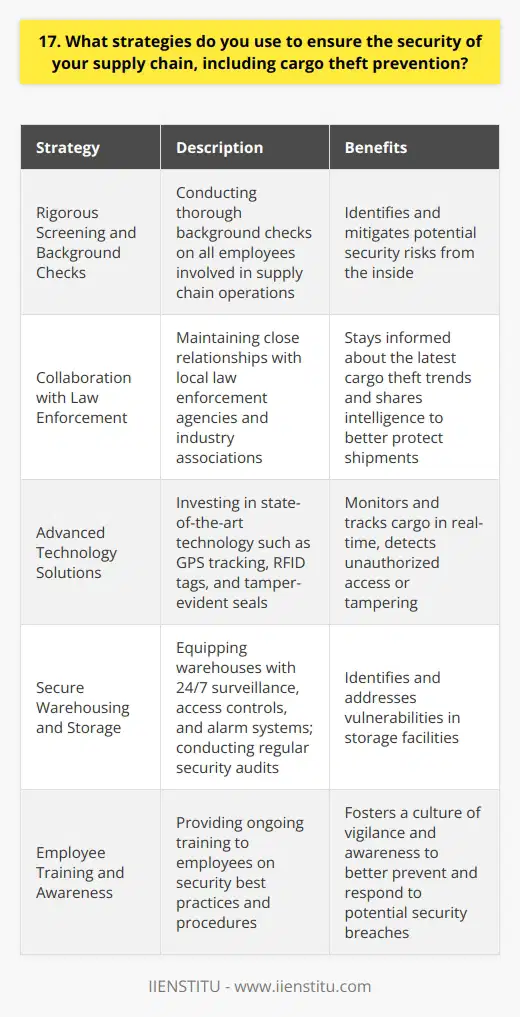
18. How do you incorporate risk management into your supplier selection and evaluation process?
When selecting and evaluating suppliers, I prioritize risk management to ensure a stable and reliable supply chain. Here are some key aspects of my approach:
Thorough Due Diligence
I conduct extensive research on potential suppliers, assessing their financial stability, reputation, and compliance with industry standards. This helps me identify and mitigate risks early in the process.
On-Site Visits and Audits
Whenever possible, I visit supplier facilities to observe their operations firsthand. This allows me to assess quality control measures, working conditions, and overall professionalism. Regular audits help ensure ongoing compliance and risk mitigation.
Diversification and Contingency Planning
I believe in diversifying the supplier base to reduce dependence on any single source. By establishing relationships with multiple suppliers, I create contingency plans to mitigate the impact of potential disruptions or failures.
Continuous Monitoring and Communication
I maintain open lines of communication with suppliers to stay informed about any changes or challenges they face. Regular performance reviews and risk assessments allow me to proactively address issues before they escalate.
Contractual Safeguards
I work closely with legal teams to incorporate robust contractual provisions that protect against risks such as intellectual property infringement, data breaches, and supply disruptions. Clear expectations and consequences are established from the outset.
By incorporating these risk management strategies into my supplier selection and evaluation process, I strive to build a resilient and trustworthy supply chain that supports the company's long-term success.
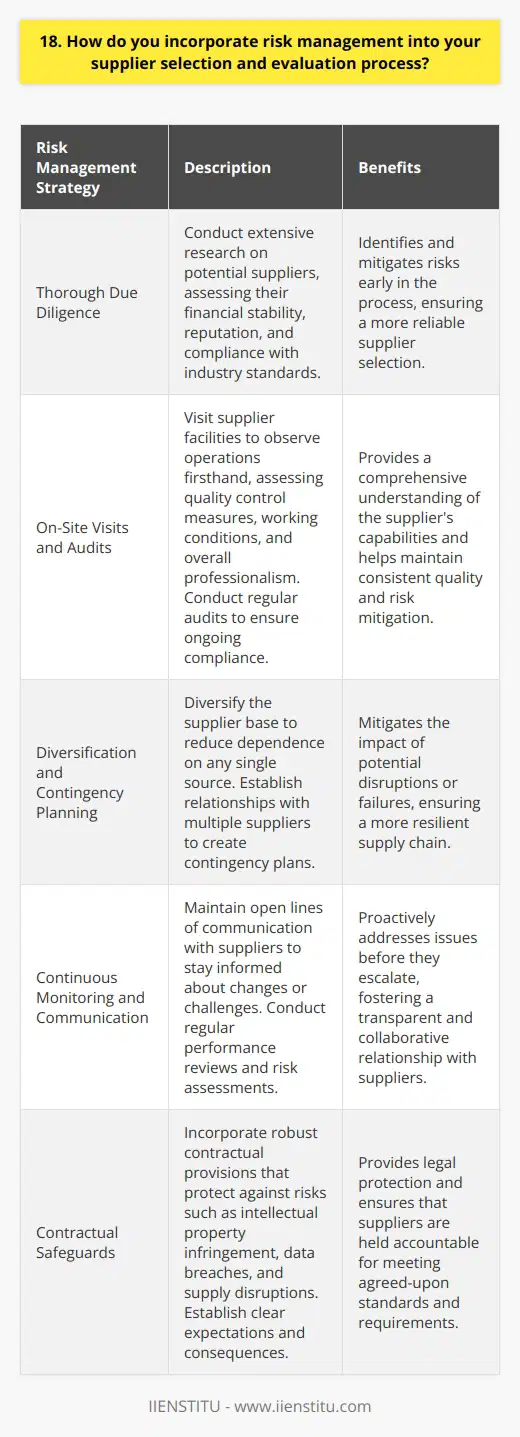
19. What steps do you take to ensure the quality and safety of products throughout your supply chain?
At our company, we take several steps to ensure the quality and safety of products throughout our supply chain. First and foremost, we have a rigorous supplier selection process. We only work with suppliers who meet our strict quality and safety standards.
Regular Audits and Inspections
We conduct regular audits and inspections of our suppliers' facilities to ensure they maintain these standards. During these visits, we check everything from their manufacturing processes to their storage and handling procedures.
Traceability is Key
Traceability is another key aspect of our quality and safety assurance efforts. We use advanced tracking systems to monitor our products at every stage of the supply chain. This allows us to quickly identify and address any issues that may arise.
Continuous Improvement
We also have a team dedicated to continuous improvement. They're constantly looking for ways to enhance our quality and safety protocols. We believe there's always room for improvement, no matter how well we're doing.
Collaboration with Suppliers
Finally, we view our suppliers as partners in quality and safety. We work closely with them, sharing best practices and providing support when needed. By collaborating closely, we can ensure that our products meet the highest standards from start to finish.
In my role as Quality Assurance Manager, I've seen firsthand how these steps contribute to the exceptional quality and safety of our products. It's a comprehensive approach that involves everyone in the supply chain, and it's something I'm truly proud to be a part of.
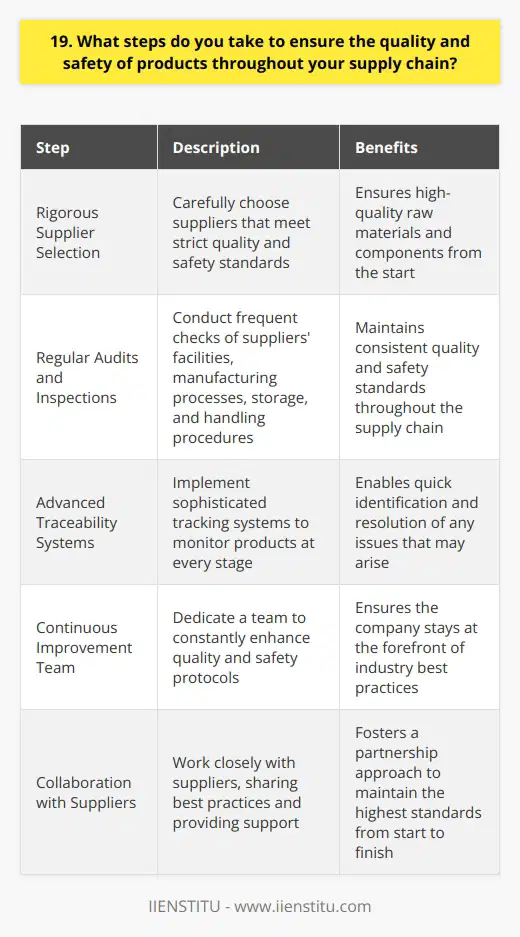
20. How do you manage risks associated with inventory management and stock levels?
When it comes to managing risks associated with inventory management and stock levels, I employ several strategies. First and foremost, I always strive to maintain accurate and up-to-date records of our current inventory. This allows me to quickly identify any discrepancies or potential issues before they become major problems.
Forecasting Demand
One key aspect of risk management in inventory is accurately forecasting demand. I analyze historical sales data, market trends, and customer behavior to predict future needs. By anticipating demand fluctuations, I can adjust stock levels accordingly, minimizing the risk of overstocking or stockouts.
Safety Stock
To further mitigate risks, I implement a safety stock system. I calculate optimal safety stock levels based on lead times, demand variability, and service level targets. This buffer inventory helps prevent stockouts during unexpected spikes in demand or supply chain disruptions.
Supplier Relationships
Building strong relationships with reliable suppliers is crucial for managing inventory risks. I carefully vet and select suppliers who consistently deliver quality products on time. Regular communication and collaboration with suppliers help me stay informed about potential supply chain issues and proactively address them.
Continuous Monitoring
I believe in the importance of continuous monitoring when it comes to inventory management. I regularly review stock levels, sales trends, and supplier performance to identify any red flags early on. By staying vigilant and proactive, I can quickly adapt to changing circumstances and minimize risks.
Technology and Automation
Leveraging technology and automation is another way I manage inventory risks. I utilize inventory management software to track stock levels in real-time, set up automated reorder points, and generate reports for analysis. These tools help me make data-driven decisions and reduce the risk of human error.
In summary, my approach to managing inventory risks involves accurate record-keeping, demand forecasting, safety stock, strong supplier relationships, continuous monitoring, and leveraging technology. By implementing these strategies, I aim to optimize stock levels, prevent stockouts, and ensure smooth operations while minimizing risks.
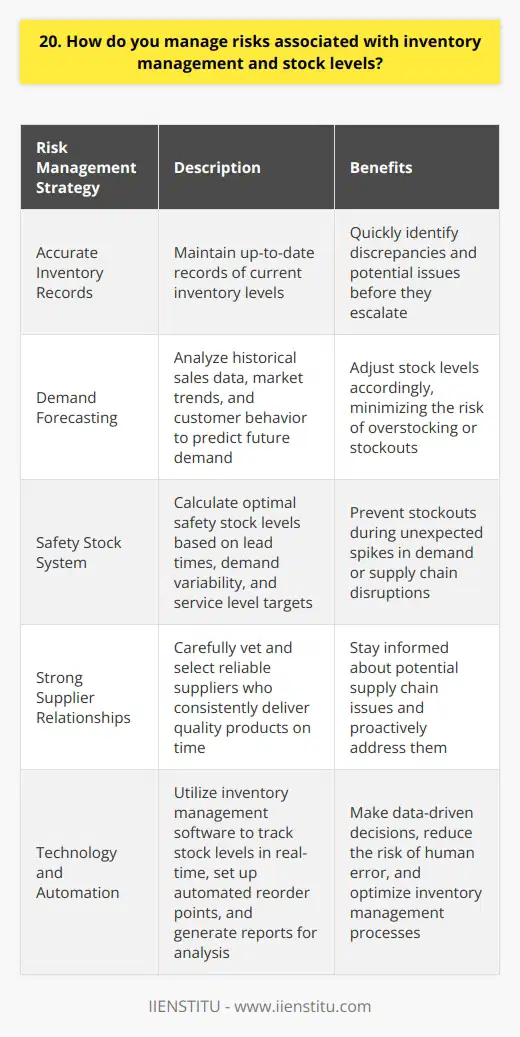
21. What processes do you have in place to monitor and manage supplier performance?
Establish clear performance metrics
I believe the first step is to agree on quantifiable metrics that align with business needs. These might include on-time delivery, defect rates, responsiveness, and cost savings. The specific KPIs depend on what's most critical for our supply chain.
Conduct regular business reviews
Meeting with key suppliers quarterly is important to openly discuss performance, challenges, and opportunities for improvement. I find that frequent touchpoints help build trust and partnership. We can collaborate to solve issues before they escalate.
Leveraging a supplier scorecard
I'm a fan of using a balanced scorecard to track and rate suppliers on the agreed KPIs. The scorecard provides an objective snapshot of performance that can facilitate productive discussions. Sharing the scorecard with suppliers increases transparency and accountability.
Taking corrective actions
If a supplier is underperforming, I believe in understanding root causes and jointly developing corrective action plans. This could involve visiting the supplier's site to observe processes and provide improvement ideas. Follow-up audits can verify if the remediation measures worked.
Ultimately, closely monitoring supplier performance through quantitative and qualitative methods is key to driving continuous improvement. An early warning system helps address risks before supply disruptions occur. Of course, it's also important to recognize and reward suppliers that consistently meet or exceed targets.
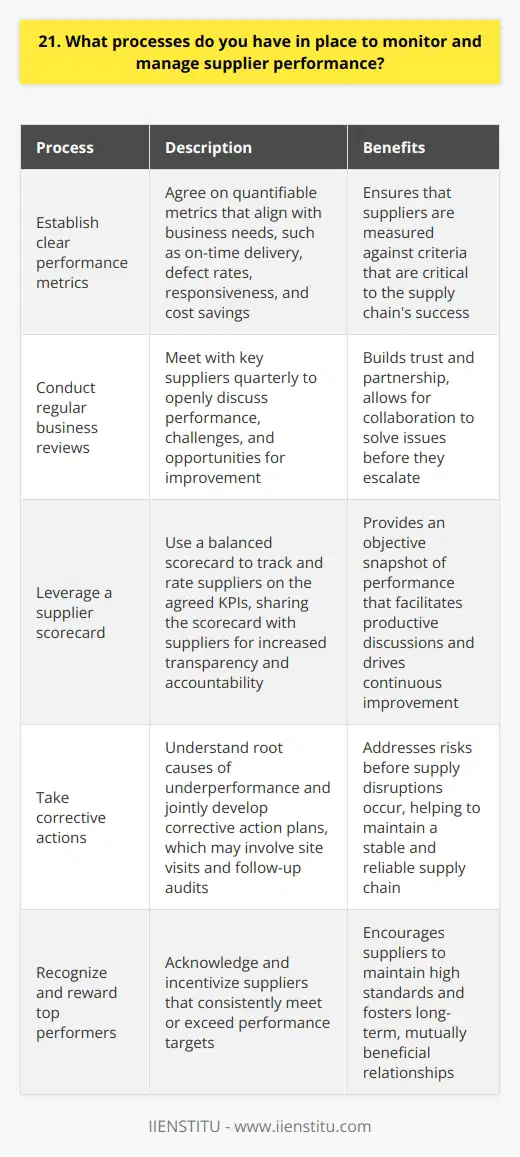
22. How do you ensure that your supply chain is compliant with relevant regulations and standards?
As the supply chain manager, I take a proactive approach to ensure compliance with regulations and standards. Here are some key strategies I employ:
Staying Up-to-Date with Regulations
I make it a priority to stay informed about the latest regulations and standards affecting our industry. This involves regularly reviewing government websites, attending industry conferences, and participating in relevant webinars. By keeping my finger on the pulse, I can quickly adapt our supply chain processes to meet any new requirements.
Collaborating with Legal and Compliance Teams
I work closely with our legal and compliance departments to interpret complex regulations and translate them into actionable steps. We have regular meetings to discuss potential risks, review our current practices, and identify areas for improvement. This collaborative approach ensures that our supply chain remains compliant while also being efficient and cost-effective.
Implementing Robust Monitoring Systems
To maintain compliance, I have implemented robust monitoring systems throughout our supply chain. This includes regular audits of our suppliers, warehouses, and transportation partners. We use advanced software to track and trace our products, ensuring they meet all necessary standards. If any issues arise, we have clear protocols in place to address them promptly.
Training and Education for Team Members
I believe that compliance is everyone's responsibility, not just mine. That's why I invest in regular training and education programs for my team members. We cover topics like proper documentation, handling hazardous materials, and adhering to ethical sourcing practices. By empowering my team with knowledge, I create a culture of compliance that permeates our entire supply chain.
At the end of the day, ensuring compliance is about being proactive, vigilant, and adaptable. It's a continuous process that requires dedication and collaboration from all stakeholders. As the supply chain manager, I take this responsibility seriously and work tirelessly to maintain the highest standards of compliance.
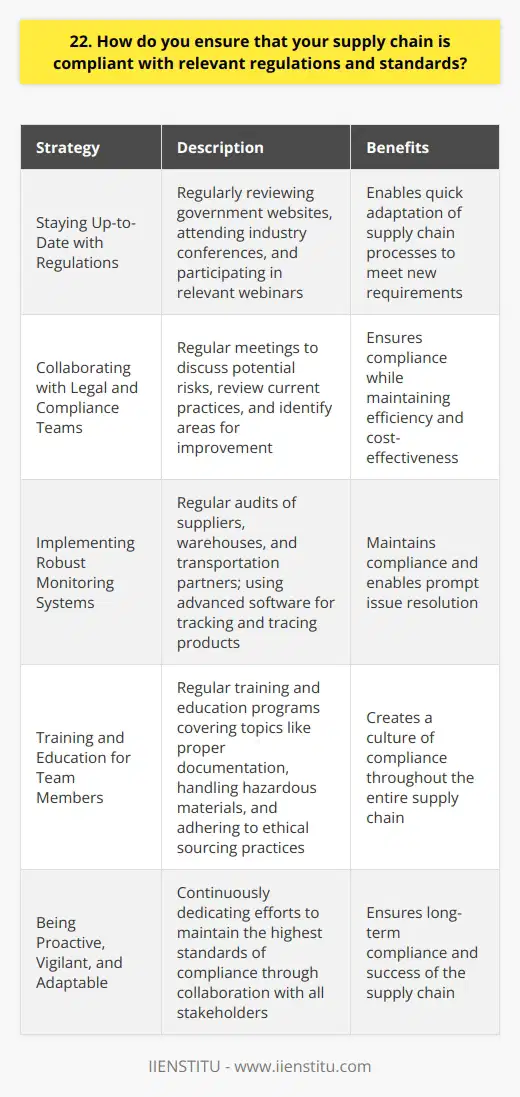
23. What strategies do you use to manage risks associated with transportation and logistics?
When it comes to managing risks associated with transportation and logistics, I have a few key strategies that I rely on. First and foremost, I always make sure to thoroughly research and vet any new suppliers or partners before entering into a contract with them. This includes looking into their safety record, financial stability, and references from other clients.
Contingency Planning
Another important aspect of risk management in this field is having robust contingency plans in place. Whether it's a natural disaster, a labor strike, or an unexpected surge in demand, I've learned that it pays to be prepared for anything. I work with my team to develop detailed action plans for various scenarios, so we can quickly adapt and keep things moving smoothly.
Leveraging Technology
In today's fast-paced business environment, leveraging technology is also crucial for managing logistics risks. I'm always on the lookout for new software and tools that can help us track shipments in real-time, optimize routes, and streamline communication with drivers and warehouses. By staying on the cutting edge of these innovations, we can spot potential issues early and take proactive steps to mitigate them.
Collaboration and Communication
Finally, I believe that close collaboration and open communication with all stakeholders is essential for effective risk management in transportation and logistics. Whether it's working with our internal teams, our clients, or our partners in the supply chain, I prioritize building strong relationships based on trust and transparency. By keeping everyone informed and aligned, we can navigate even the toughest challenges and deliver results.
At the end of the day, managing risks in this industry requires a combination of careful planning, adaptability, and teamwork. It's not always easy, but I find it incredibly rewarding to problem-solve and keep goods flowing smoothly to their destinations, no matter what obstacles come our way.
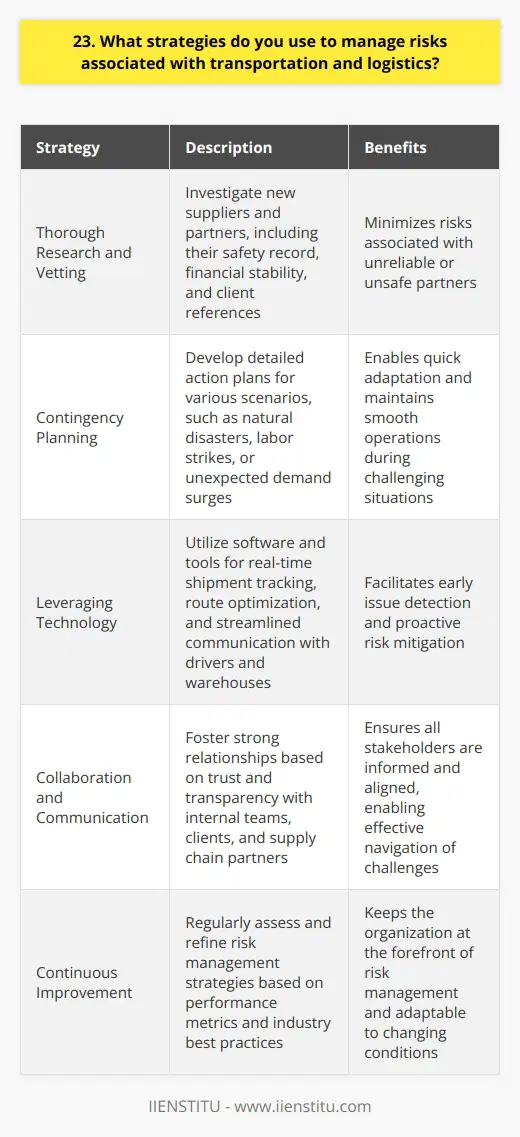
24. How do you incorporate sustainability and environmental risks into your supply chain risk management?
At our company, we take sustainability and environmental risks seriously when it comes to supply chain management. We believe that incorporating these factors is not only the right thing to do for the planet, but it also makes good business sense.
Assessing Suppliers
One of the key ways we address sustainability is by carefully assessing our suppliers. We look at their environmental track record, waste management practices, and carbon footprint. By partnering with suppliers who share our green values, we can reduce our overall environmental impact.
I remember visiting one of our main suppliers last year and being impressed by their state-of-the-art recycling facility. It showed me that they were walking the walk when it came to sustainability.
Optimizing Transportation
Another important aspect is optimizing our transportation and logistics. We aim to minimize empty miles and consolidate shipments whenever possible. This not only cuts costs but also significantly reduces our carbon emissions.
I worked closely with our logistics team to map out more efficient delivery routes. It was a challenging project, but seeing the reduction in fuel consumption made it all worthwhile.
Promoting Circular Economy
We're also big believers in the circular economy model. Whenever feasible, we look for ways to reuse, refurbish, or recycle materials. This helps conserve resources and keeps waste out of landfills.
One initiative I'm particularly proud of is our product take-back program. Customers can send back old products, and we'll either refurbish them or responsibly recycle the components. It's a win-win for everyone involved.
At the end of the day, managing sustainability and environmental risks in our supply chain is an ongoing process. It requires constant vigilance, innovation, and collaboration with our partners. But I firmly believe it's a challenge we must embrace for the sake of our planet and future generations.
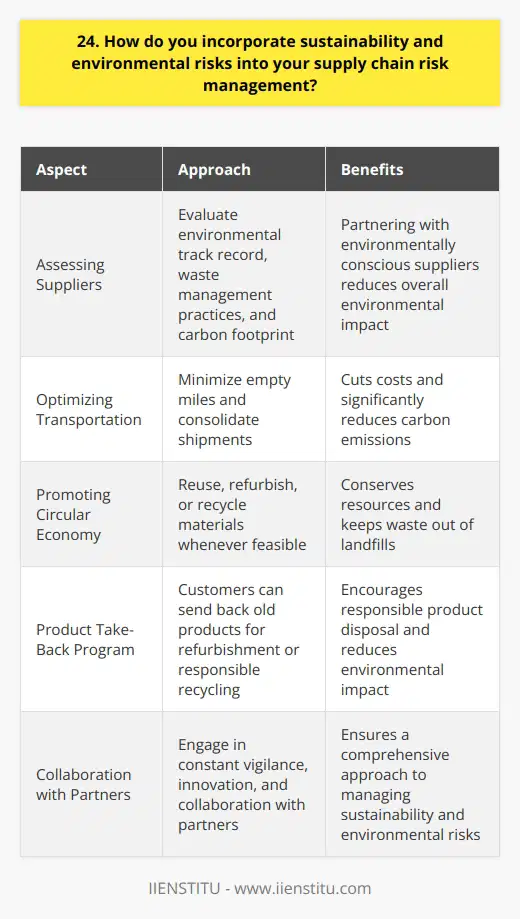
25. What steps do you take to manage risks associated with product obsolescence and market shifts?
When it comes to managing risks associated with product obsolescence and market shifts, I take a proactive approach. I believe in staying ahead of the curve by constantly monitoring industry trends and customer needs. This allows me to anticipate potential changes and adapt our product offerings accordingly.
Conducting Regular Market Research
One of the key steps I take is conducting regular market research. I analyze competitor products, gather customer feedback, and study market reports. This helps me identify emerging trends and potential disruptions in the market. By staying informed, I can make data-driven decisions to mitigate risks.
Collaborating with Cross-Functional Teams
I also believe in collaborating closely with cross-functional teams, including product development, sales, and customer support. By fostering open communication and sharing insights, we can collectively assess risks and develop strategies to address them. Collaboration ensures that everyone is aligned and working towards the same goals.
Embracing Innovation and Agility
In today's fast-paced business environment, embracing innovation and agility is crucial. I encourage my team to think outside the box and explore new technologies and approaches. By fostering a culture of innovation, we can stay ahead of the curve and quickly adapt to changing market conditions.
Continuously Monitoring and Adapting
Finally, I believe in continuously monitoring and adapting our strategies. I regularly review our product roadmap, assess customer feedback, and track key performance indicators. If I notice any red flags or potential risks, I take swift action to course-correct and ensure we remain competitive in the market.
By taking these proactive steps, I have successfully navigated product obsolescence and market shifts in my previous roles. I am confident that my approach can help mitigate risks and drive long-term success for the company.
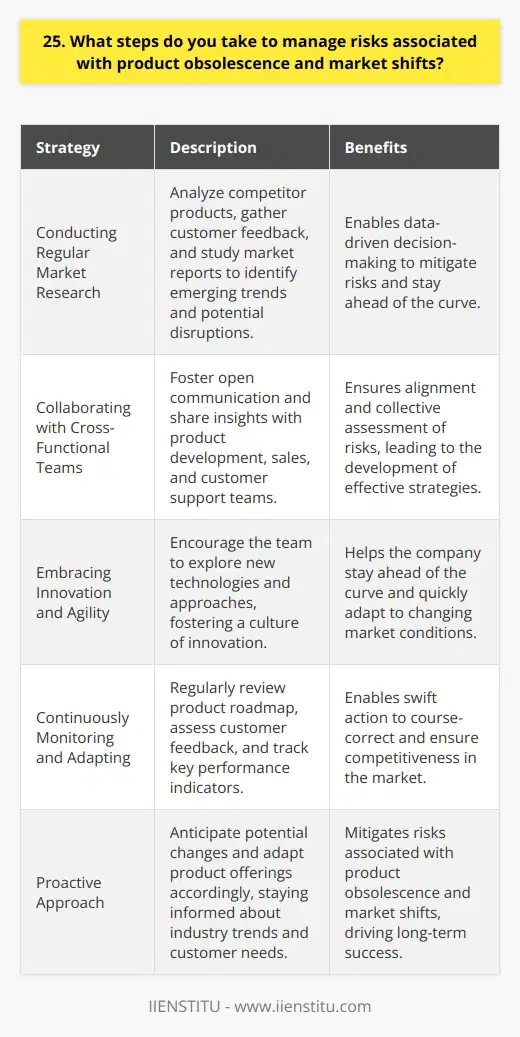
26. How do you foster a culture of risk awareness and preparedness within your organization?
As a leader, I believe in creating a culture of risk awareness and preparedness through open communication and education. I make it a priority to regularly discuss potential risks with my team and encourage them to do the same. By fostering an environment where everyone feels comfortable sharing their concerns, we can proactively identify and address issues before they escalate.
Conducting Regular Risk Assessments
I also implement regular risk assessments across all departments. This helps us stay vigilant and prepared for any potential challenges. We review our processes, identify vulnerabilities, and develop contingency plans to mitigate risks. I believe that by being proactive, we can minimize the impact of unexpected events on our operations.
Encouraging Employee Involvement
Another key aspect of fostering risk awareness is encouraging employee involvement. I empower my team members to take ownership of risk management within their roles. We provide training and resources to help them identify and report potential risks. By actively engaging employees in the process, we create a shared sense of responsibility for maintaining a safe and secure work environment.
Leading by Example
Finally, I believe in leading by example when it comes to risk awareness. I make sure to follow proper protocols and procedures myself, and I'm always open to feedback and suggestions from my team. By demonstrating a commitment to risk management at the highest levels of the organization, I set the tone for everyone else to follow.
In summary, fostering a culture of risk awareness and preparedness is an ongoing process that requires open communication, regular assessments, employee involvement, and strong leadership. By prioritizing these elements, I strive to create a resilient and adaptable organization that can navigate challenges with confidence.
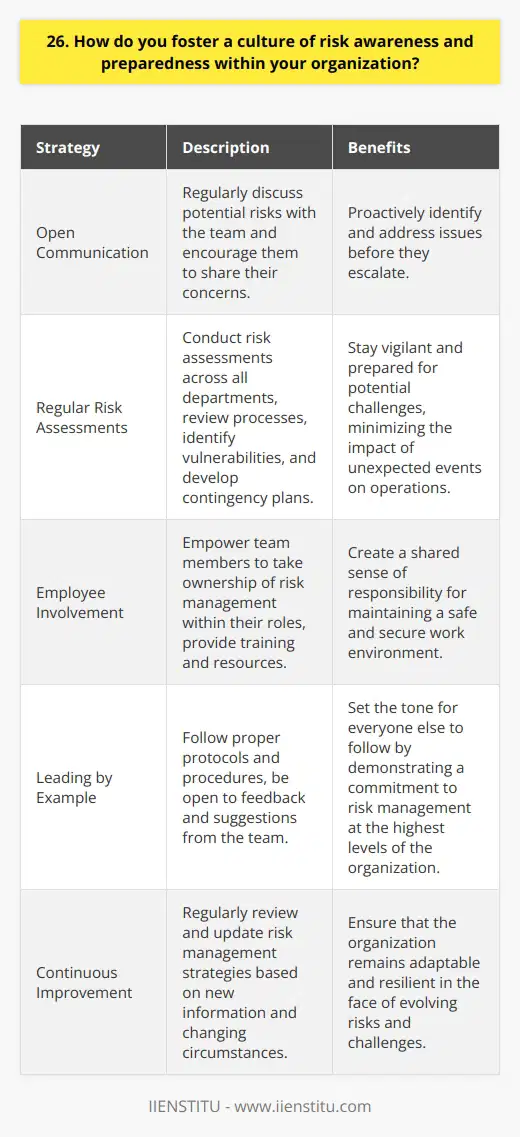
27. What processes do you have in place to conduct regular risk assessments and audits?
As a professional in risk management, I have implemented several processes to ensure regular risk assessments and audits. These measures are crucial for identifying potential threats and vulnerabilities within our organization.
Establishing a Risk Assessment Schedule
I work closely with my team to create a comprehensive risk assessment schedule. We conduct assessments on a quarterly basis, focusing on different areas of the company each time. This approach allows us to thoroughly evaluate risks and make necessary adjustments.
Involving Key Stakeholders
During the risk assessment process, I engage key stakeholders from various departments. Their insights and expertise are invaluable in identifying risks specific to their areas. By collaborating with them, we develop a holistic view of the organization's risk landscape.
Conducting Thorough Audits
In addition to risk assessments, I oversee regular audits to ensure compliance with internal policies and industry regulations. My team follows a structured audit plan, examining critical processes, systems, and documentation. We document our findings and provide recommendations for improvement.
Leveraging Technology
I leverage advanced risk management software to streamline the assessment and audit processes. These tools help us track risks, monitor progress, and generate reports efficiently. By utilizing technology, we can identify trends and make data-driven decisions.
Continuous Improvement
I believe in the importance of continuous improvement when it comes to risk management. After each assessment and audit, I review the results with my team and stakeholders. We discuss lessons learned, best practices, and areas for enhancement. This feedback loop enables us to refine our processes and stay proactive in mitigating risks.
In summary, my approach to risk assessments and audits is thorough, collaborative, and technology-driven. By establishing a regular schedule, involving key stakeholders, conducting audits, leveraging tools, and embracing continuous improvement, I ensure that our organization effectively identifies and manages risks.
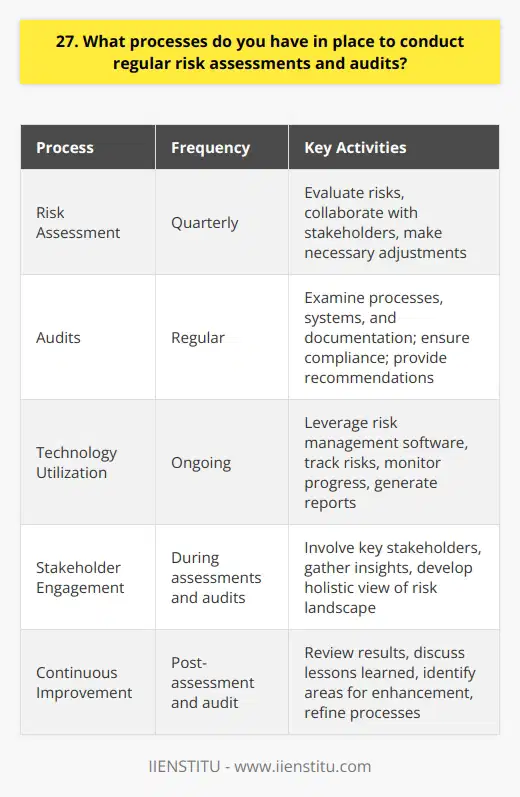
28. How do you manage risks associated with intellectual property and counterfeiting in your supply chain?
At my previous company, we took a proactive approach to managing risks associated with intellectual property and counterfeiting. I believe it's crucial to have a comprehensive strategy in place.
Thorough Supplier Vetting
The first step is thoroughly vetting all suppliers. We conducted extensive background checks and required detailed documentation proving their legitimacy. Building strong, trusting relationships with a select group of reliable suppliers was key.
Robust Quality Control
Next, implementing robust quality control measures is essential. I worked with my team to develop strict inspection protocols. We examined incoming goods to verify authenticity and adherence to our IP standards.
Leveraging Technology
Leveraging technology is also important in combating counterfeiting. At my last job, we invested in sophisticated tracking systems. These allowed us to monitor our supply chain from start to finish, flagging any suspicious activity.
Collaboration and Training
Finally, I firmly believe in the power of collaboration and training. We regularly communicated with our suppliers, making our expectations crystal clear. Ongoing training kept our team vigilant in spotting potential IP infringements.
While no system is perfect, I'm confident that by implementing a multifaceted approach, we can effectively mitigate risks. It takes constant vigilance, but protecting our intellectual property and brand integrity is always worth the effort.

29. What strategies do you use to ensure the continuity of your supply chain during times of crisis?
As a supply chain professional, I have developed several strategies to maintain the flow of goods during crises. These approaches have proven effective in minimizing disruptions and ensuring business continuity.
Diversifying Suppliers
One key strategy I employ is diversifying our supplier base across multiple geographic regions. By not relying on a single source, we reduce the risk of complete supply chain breakdowns. If one supplier faces issues, we can quickly pivot to alternative providers.
Building Strong Relationships
I believe in fostering strong, long-term relationships with our suppliers. Regular communication and collaboration help us navigate challenges together. During the early stages of the COVID-19 pandemic, our close partnerships allowed us to coordinate contingency plans and adapt swiftly.
Implementing Risk Assessment
Another crucial aspect is conducting thorough risk assessments of our supply chain. I analyze potential vulnerabilities, such as geopolitical instability or natural disasters, and develop mitigation strategies. This proactive approach helps us anticipate and prepare for various crisis scenarios.
Embracing Technology
I'm a firm believer in leveraging technology to enhance supply chain resilience. By implementing real-time monitoring systems and data analytics, we can quickly identify bottlenecks and take corrective actions. During a recent port congestion crisis, our advanced tracking tools allowed us to reroute shipments and minimize delays.
Continuous Improvement
Finally, I prioritize continuous improvement and learning from past experiences. After each supply chain disruption, my team conducts a thorough post-mortem analysis. We identify areas for improvement and implement necessary changes to strengthen our crisis response capabilities.
By employing these strategies, I have successfully navigated numerous supply chain challenges and delivered uninterrupted service to our customers.
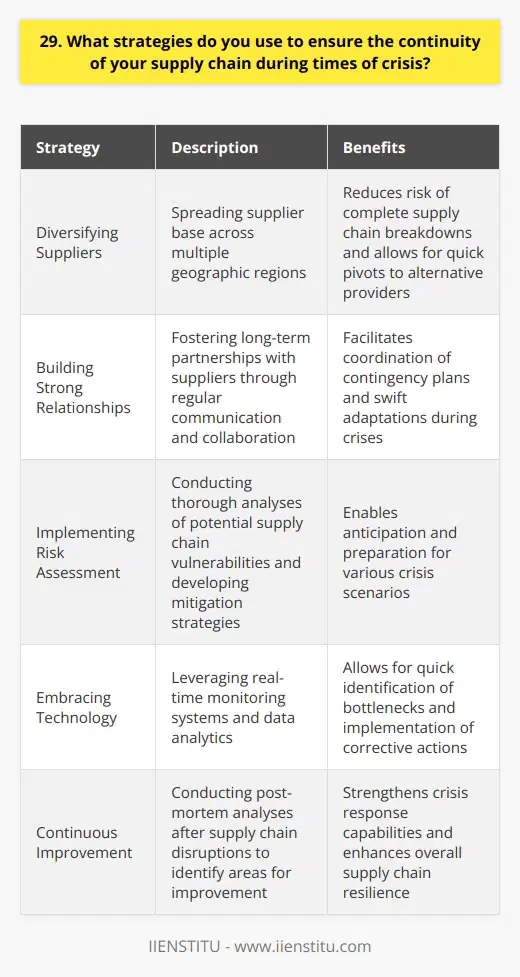
30. How do you continuously improve and adapt your risk management strategies based on lessons learned?
In my experience, continuously improving risk management strategies is crucial for long-term success. I believe in proactively seeking out lessons learned from past projects and initiatives. By critically analyzing what worked well and what could be improved, I gain valuable insights to refine my approach.
Gathering Feedback and Data
I make it a priority to gather feedback from stakeholders and team members involved in each project. Their perspectives help me identify potential gaps or areas for improvement in our risk management plans. Additionally, I collect relevant data and metrics to quantitatively assess the effectiveness of our strategies.
Conducting Regular Reviews
To stay agile, I schedule regular reviews of our risk management processes. During these reviews, I collaborate with my team to discuss the lessons learned and brainstorm ideas for optimization. We challenge assumptions, explore alternative approaches, and strive to find innovative solutions.
Implementing Enhancements
Once we have identified opportunities for improvement, I take the lead in developing and implementing enhancements to our risk management strategies. This may involve updating documentation, refining processes, or introducing new tools and techniques. I ensure that these changes are communicated effectively to all relevant stakeholders.
Continuous Learning and Adaptability
I firmly believe in the importance of continuous learning and staying up-to-date with industry best practices. I actively seek out training opportunities, attend conferences, and engage with professional networks to expand my knowledge and skills in risk management. By staying informed about the latest trends and methodologies, I can adapt our strategies to changing business landscapes.
Ultimately, my approach to improving risk management is centered around a culture of continuous improvement, collaboration, and adaptability. By leveraging lessons learned and fostering a proactive mindset, I aim to strengthen our organization's resilience and mitigate potential risks effectively.
